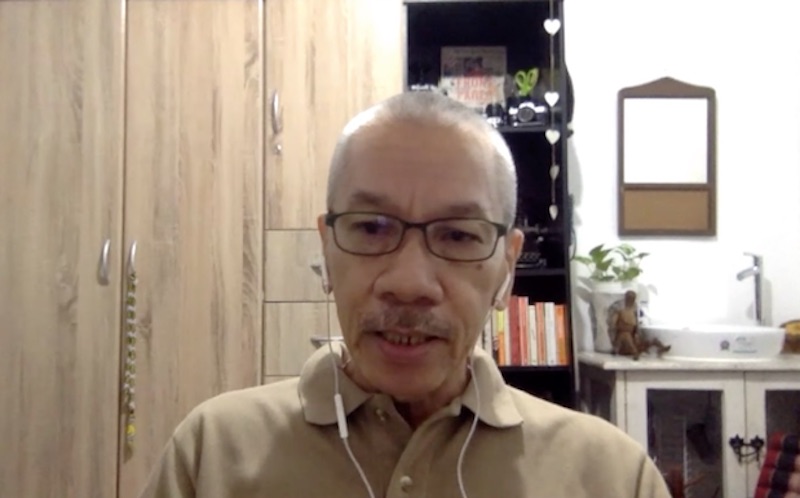KORONADAL CITY (MindaNews /20 June) – “Be aware of the risks and what you can do to reduce the risks… Safety is paramount in covering disasters,” the Southeast Asia coordinator for the International News Safety Institute reminded at least 20 Mindanawon journalists from print, broadcast and online based in the Zamboanga Peninsula and Northern Mindanao regions during a safety training on covering disasters conducted virtually on Friday morning.
Red Batario, INSI coordinator and executive director of the Center for Community Journalism and Development stressed that before covering disasters, journalists need to conduct a risk assessment of the place of assignment, which includes knowing the terrain, hospitals and emergency services in the area, among others.
 Red Batario, Executive Director of the Center for Community Journalism and Development and Southeast Asia coordinator for the International News Safety Institute during the online safety training on covering disasters on June 18, 2021.
Red Batario, Executive Director of the Center for Community Journalism and Development and Southeast Asia coordinator for the International News Safety Institute during the online safety training on covering disasters on June 18, 2021.
The safety training on covering disasters is the second of a four-series training in Mindanao on “Strengthening Safety of Journalists and Professional Journalistic Standards in the Philippines,” a project of the United Nations Educational, Scientific and Cultural Organization (UNESCO) -Jakarta supported by the Netherlands Funds-in-Trust, in partnership with MindaNews.
The training, aimed at equipping participants with basic knowledge, tools and skills in keeping safe before, during and after disasters, was attended by a mix of young and veteran male and female journalists from the two regions.
Batario also stressed the important of wearing the appropriate clothing and footwear (depending on the disaster), bring first aid kit (e.g. paracetamol, anti-diarrheal, antihistamine, antiseptic wipes and dissolvable water purifier), solar-powered light, and water and food good for at least 72 hours during coverage, he said.
With the ongoing COVID-19 pandemic, Batario said journalists doing fieldwork must make it a habit to wear personal protective equipment such as face masks and face shields, as they could either get infected or spread the virus unknowingly if they are asymptomatic.
“All the time, observe health protocols,” Batario said.
He also reminded journalists to disinfect themselves and make sure they dispose of the used PPEs properly.
A communications protocol with the newsroom, family and colleagues must be set up so they will know where or how the journalists are doing while covering disasters, Batario said, noting that it is important to draw up a contingency plan for untoward incidents.
While on the field, journalists need to observe situational awareness of the surroundings to help keep themselves safe from harm, he said. “Have a keen sense of awareness,” he added.
When deployed to disaster-stricken areas, journalists should respect the victims’ grief or privacy and should not stand in the way of emergency or rescuers to get a good video, photo or sound bites, he added.
After covering disasters, Batario suggested that journalists undergo a stress debriefing with their newsroom or peers for their well-being.
Mindanao, the second largest island-grouping in the Philippines, has experienced devastations due to natural and man-made disasters, hence the need to continue instilling a safety mindset for journalists covering the island.
In the last quarter of 2019, a series of earthquakes above Magnitude 6 struck North Cotabato, Davao del Sur and neighboring areas, leveling houses and destroying vital public infrastructure. A hotel in Kidapawan City and a condominium in Davao City also collapsed.
Two strong typhoons also hit what used to be “typhoon-free Mindanao” — Tropical Storm Sendong (Washi) in December 2011 and Category 5 super typhoon Pablo (Bohpa) in December 2012.
Journalists Froilan Gallardo and Bobby Timonera of MindNews and Divina Suson of the Philippine Daily Inquirer also shared their experiences while covering disasters.
Gallardo narrated the importance of planning to ensure safety for the journalist and for his equipment as well, a major lesson learned during their coverage of the flooding in Camiguin in November 2001. Gallardo and Timonera joined Manila-based reporters in speedboat they hired to get to Camiguin quick but the engine conked out along the way. A radio station reported them missing. When they reached Camiguin, Gallardo took off his shoes unaware that the water was too deep he and his cameras landed on a sea of tuyom (sea urchins).
“One mistake you have, mag pile up yun kasi wala kang proper planning, proper assessment,” Gallardo noted.
Timonera said another lesson learned from the Camiguin coverage is that “sometimes, having money can lead to more disasters.” He said the Manila-based reporters had money to hire a speedboat so they hired one instead of wait for the weather to clear up a bit and take the ferry. He said if they had waited, they would have reached Camiguin dry. “All of us were wet,” he said, recalling that the Camiguin-bound ferry from Cagayan de Oro actually passed by while they were stuck in the middle of the sea because the speedboat’s engine conked out.
Timonera also said the experience during Typhoon Sendong in 2011 made him more conscious of monitoring weather updates.
A young reporter asked what to do if confronted with a situation where you are caught between taking photos or video or saving the life of someone who needs help.
“Humanity first,” Batario replied. But he also emphasized the need for journalists to undergo trainings on basic first aid.
Suson spoke of how she had to go on quarantine and have an RT-PCR test last year after covering the first arrival from Metro Manila of locally stranded individuals at the Laguindingan Airport in Misamis Oriental. She had intended to interview an LSI, supposedly from a distance, but ended up helping a mother who was carrying two young children – one aged 10 months, the other around two to three years old – inside the bus that would bring them to their respective provinces. The toddler kept moving and slipped from the mother’s hands, falling on the floor of the bus. Suson picked up the child who embraced her.
The safety training on covering disasters is the second of a four-series training on “Strengthening Safety of Journalists and Professional Journalistic Standards in the Philippines,” a project of the United Nations Educational, Scientific and Cultural Organization (UNESCO) -Jakarta supported by the Netherlands Funds-in-Trust, in partnership with MindaNews.
Before the training on safety during disasters, the four-series trainings in Mindanao began on June 4 with a Safety Training in Covering the COVID-19 Pandemic. The two other trainings are on “Digital Safety of Journalists” and “Covering Peace and Conflict in Mindanao.”
Dr. Ming Lim Kuok, UNESCO-Jakarta communications specialist, said the agency is glad to support the training and capacity building for journalists in Mindanao in collaboration with the Mindanao Institute of Journalism, which runs the Davao City-based news service, MindaNews and its online publication, mindanews.com.
He thanked the Government of the Netherlands for providing funding support to the safety training.
“The training today … is at the core of what UNESCO does, which is to ensure a free flow of information and by that we include freedom of expression, press freedom and, of course, safety of journalists,” Ming said.
He noted “that without journalists being safe to do their work, we will not be able to get the information out to the public.” (Bong Sarmiento / MindaNews)
